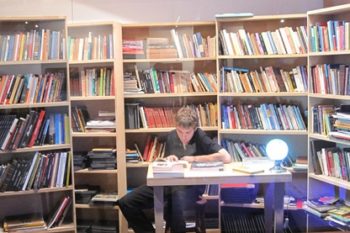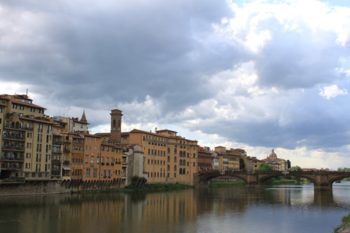This is a guest post by Gayle Pescud. Gayle lives and works in Bolgatanga, Ghana. She writes G-lish with her partner Godwin.
I probably shouldn’t tell you this, but I have absolutely no sense of direction. I mean, not a single cell in my body has any idea where it is once I turn a few corners, least of all my brain cells. As a collective, my brain cells throw their arms up and go on strike if I travel further than right, left, and right again. Game over.
So, I can only ever write a guide book for a country I have spent nearly four years traversing because it takes me this long to work out where I am and where I’m going—but when I work it out, I really work it out.
(I’ll never get a job as a drop-in guide book writer after this, but hey, I don’t want to be a hired guide writer, I want to keep writing about what inspires me and that happens to be travel in Ghana and making a difference.)
The only way I know how to get anywhere in Ghana now is because I learnt the way by heart, slowly, like one memorises algebraic equations.
Upon arriving in circular, hilly Cape Coast the first time I almost turned around and fled. (Of course, had I actually attempted to run home, I would have landed in South America, not Australia, such is my directional aptitude.) Navigating that town is like dropping you in advanced algebra before you’ve learnt to add one and one. Thank goodness, then, I was surrounded by knowledgeable, helpful and directionally gifted individuals who held my hand and made sure I got where I needed to go.
One of my greatest moments traveling in the past four years was the day I helped guide others around Cape Coast for the first time. When all my helpful buddies had left and I was then the most long standing volunteer, I did it. “I am directing people around a small African town!” I wrote in my journal. I still couldn’t direct myself around half of Sydney.
They haven’t said anything yet, but I know my parents are probably surprised, therefore, that I have co-authored a guide book. One evening my parents and I had dinner in a new part of Sydney. I drove there myself and managed to find the restaurant well enough. On the way out of that area, I had the map on my lap again, music playing, singing out loud; I was happy. Then I had to cross a bridge. My parents were in their car behind me. Just as I crossed and turned left, in the rear view I saw them turning right. Apparently my Mum said, “There goes Gayle again, we’ll see her in a few hours…” (The half hour trip took me about two hours, but I didn’t mind. I’ve often worked out how to get somewhere new precisely because I’ve been lost there before.)
Trust me, I thought long and hard about this guide book gig before I decided to take on the responsibility of directing others from A to B.
There are two things to my advantage in this co-authoring, guide-writing business, though.
One, my co-author extraordinaire is gifted in the directional department. That is, Godwin is the human equivalent of a bumble bee. You know, those insects fly for miles in search of tasty pollen. When they find it, they memorise the location and then fly back to the hive. When they arrive at the hive they do a little dance around the honeycomb cell to “tell” the other bees how to find that exact, tasty plant. They have a whole bee navigational system and language. Godwin is like that; he has directional ability (and he can dance).
 I can dance, but I definitely could not be a bee. I’m like a seed that gets blown by the wind, albeit dancing happily, but resigned to accept landing wherever the wind drops me. Godwin, however, can walk or drive along the back streets of a new town through crowds and rain, turning in every direction for an hour, and still know how to get back to where we started. I have no idea how he does it, but he gets it right virtually every time. I just shut up and follow. Photo credit
I can dance, but I definitely could not be a bee. I’m like a seed that gets blown by the wind, albeit dancing happily, but resigned to accept landing wherever the wind drops me. Godwin, however, can walk or drive along the back streets of a new town through crowds and rain, turning in every direction for an hour, and still know how to get back to where we started. I have no idea how he does it, but he gets it right virtually every time. I just shut up and follow. Photo credit
The second advantage is that I’ve lived here almost four years. It took a while, but directions infiltrated my brain cells. I did most of the journeys we write about twice, if not more, and took copious notes each time precisely because I knew I would need my own notes to navigate myself if I ever returned in future and because I ran an informal “guide” book in our volunteer house giving tips, advice, and directions where the formal guide was wrong. Those notes have proved to be extremely useful for our guide.
My dysfunctional navigational sense is another reason why I hardly ever relied on maps in other guide books. Well I tried. Just ask my grandma or sister about the time I directed us around Kyoto. Actually, don’t ask. This is what happened. They came to visit me when I lived in Japan for a year. I’d been there for about nine months when they arrived so I was comfortable directing us on public transport to the temple. Only we ended up on the wrong bus and in the outer suburbs of Kyoto, nowhere near the temples. And then I put us on the wrong bullet train which was headed to the wrong side of Japan, and it wasn’t because I didn’t speak Japanese; I spoke fluently. It was my inability to work out how certain places connected by looking at lines on a piece of paper. This is the story of my life.
In Ghana, when I did finally learn the lay of certain towns, like Kumasi, and compared the guide maps with this experience, I realised the maps were not accurate. I was at a double disadvantage when I tried to use them!
With all this experience in mind, in our guide we chose rather to give clear explanations for directions—although we have included a couple of key, simple maps for Accra, the capital, so visitors can orientate themselves and reach transport hubs.
You see, when writing directions in our guide I wrote for me, as if I, the worst navigator on earth, was our typical customer. My disadvantage translated to an advantage for readers of our Ghana guide. They not only get first-hand, detailed directions acquired from years of experience, but also a sympathetic writer who understands exactly where they stand and where they’re going—because I’ve been there! This is also why we included lists of toilets across the country, but that’s another story.
I must say, however, that if we add more maps in future, that will be the job of the bumblebee, not the wind-swept seed!
If you want to check out our guide, you can go to www.g-lish.org/ghanaguide where you’ll find a detailed outline and a free PDF sample.
Read more:
The rains continue in Zambia
Gayle and Godwin on their cross-cultural relationship
Speaking Ghana’s language: More about G-lish on Blogs of the World






